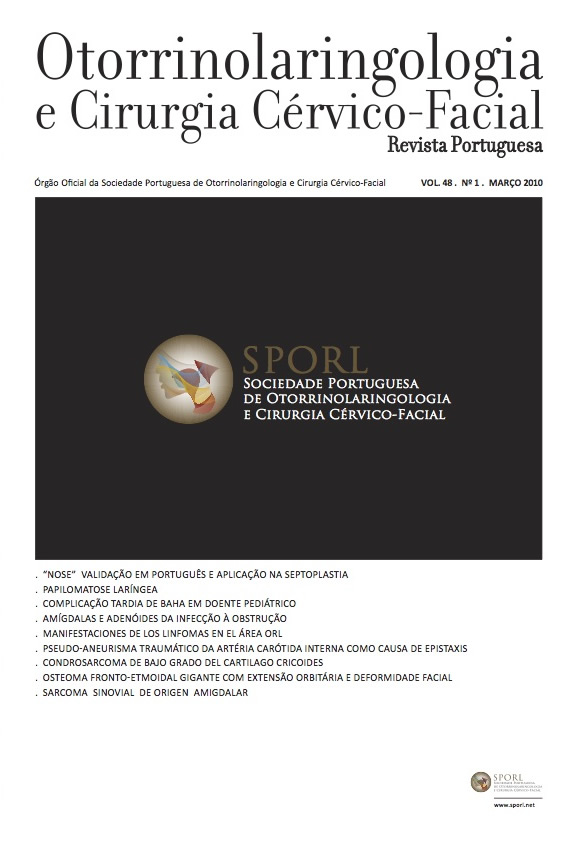Traumatic pseudoaneurysm of the internal carotid artery causing epistaxis
DOI:
https://doi.org/10.34631/sporl.261Keywords:
Epistaxis, pseudoaneurysm, internal carotid artery, endovascular therapyAbstract
Post-traumatic pseudoaneurysms of the internal carotid artery are a rare cause of epistaxis, that can be life-threatening if not adequatelly managed.
We report a case of a pseudoaneurysm of the carotid artery presenting with massive epistaxis, 11 years after craniofacial trauma. Coil embolization of the pseudoaneurysm was performed and the patient had no further episodes of epistaxis with no neurologic sequelae.
Downloads
References
Gicquel P et al. Epistaxis. Encycl Méd Chir (Elsevier Paris). Oto-rhino- laryngologie. 1995;20-310-A10:p8
Holger J. Epistaxis: a clinical study of 1724 patients. J Laryngol Otol 1974; 88: 317-27
Chaboki H et al. Cavernous carotid aneurysm presenting with epis- taxis. Head & Neck 2004 Aug; 741-746.
Wang A et al. Traumatic internal carotid artery aneurysm with rup- ture into the sphenoid sinus. Surg Neurol 1986; 25: 77-81.
Ramos A et al. Traumatic aneurysm of the internal carotid artery: A late finding presenting as a mass in the sphenoid sinus. AJNR Am J Neuroradiol 1996 Feb; 17: 222-225.
Lima A et al. Défice visual pós traumático com agravamento tardio associado a aneurisma da artéria carótida interna cervical. Acta Médica Portuguesa 1994; 7: 483-486.
Chen D et al. Epistaxis originating from traumatic pseudoaneurysm of the internal carotid artery: Diagnosis and Endovascular therapy. Laryngoscope 1998 Mar; 108: 326-331.
Van Alyea OE. Nasal sinuses: an anatomical and clinical considera- tion, 2nd ed. Baltimore: Williams & Wilkins, 1951.
Renn WH, Rhoton AL. Microsurgical anatomy of the sellar region. J Neurosurg 1975 Sep; 43(3): 288-98.
Maurer JJ, Mills M, German WJ. Triad of unilateral blindness orbi- tal fractures, and massive epistaxis after head injury. J Neurosurg 1961; 18: 837- 40.
Seftel DM, Kolson H, Gordon BS. Ruptured intracranial aneurysm with fatal epistaxis. Arch Otolaryngol 1959; 70: 52-60.
Han MH et al. Traumatic pseudoaneurysm of the intracavernous ICA presenting with massive epistaxis: imaging diagnosis and envovascular treatment. Laryngoscope 1994 Mar; 104: 370-377.
Fleisher AS, Patton JM, Tindall GT. Cerebral aneurysms of traumatic origin. Surg Neurol 1975; 4: 233-9.
Simpson RK Jr, Harper RL, Bryan RN. Emergency baloon occlusion for massive epistaxis due to traumatid carotid-cavernous aneurysm. J Neurosurg 1988; 68: 142-4.
Chambers EF et al. Traumatic aneurysm of cavernous internal caro- tid artery with secondary epistaxis. AJNR Am J Neuroradiol 1981. 2: 405-409.
Handa J, Handa H. Severe epistaxis caused by traumatic aneurysm of cavernous carotid artery. Surg Neurol 1976; 5: 241-3.
Brilstra EH, Rinkel GJ, van der Graaf Y, van Rooij WJ, et al. Treatment of intracranial aneurysms by embolization with coils. Stroke. 1999; 30: 470-76.






